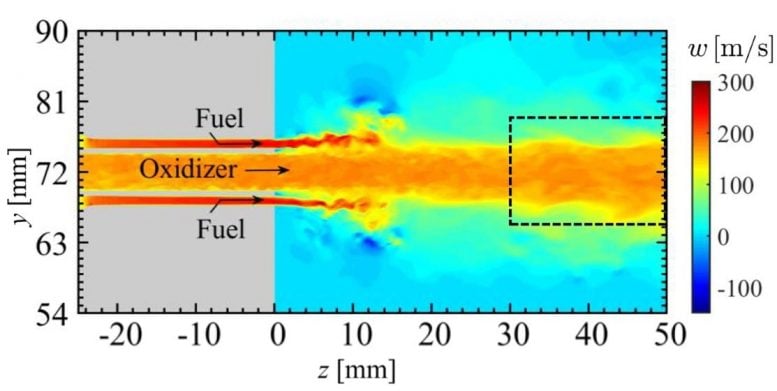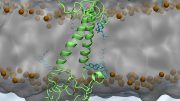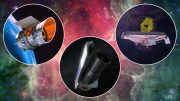
This figure shows that large-scale vortex rings are produced from the injector rim during combustion oscillations. Credit: Satomi Shima, Kosuke Nakamura, Hiroshi Gotoda, Yuya Ohmichi, and Shingo Matsuyama
Via advanced analyses, scientists shed light on the mechanism of a fatal problem plaguing combustion chambers in rocket engines.
Rocket engines contain confined combustion systems, which are, essentially, combustion chambers. In these chambers, nonlinear interactions among turbulent fuel and oxidizer flows, sound waves, and heat produced from chemical reactions, cause an unstable phenomenon called ‘combustion oscillations.’ The force of these oscillations on the body of the combustion chamber — the mechanical stress on the chamber — is high enough to threaten catastrophic failure of the engine. What causes these oscillations? The answer remains to be found.
Now, in a breakthrough, published in Physics of Fluids, a team including Prof. Hiroshi Gotoda, Ms. Satomi Shima, and Mr. Kosuke Nakamura from Tokyo University of Science (TUS), in collaboration with Dr. Shingo Matsuyama and Dr. Yuya Ohmichi from the Japan Aerospace Exploration Agency (JAXA), have used advanced time-series analyses based on complex systems to find out.
Explaining their work, Prof. Gotoda says, “Our main purpose was to reveal the physical mechanism behind the formation and sustenance of high-frequency combustion oscillations in a cylindrical combustor using sophisticated analytical methods inspired by symbolic dynamics and complex networks.” These findings have also been covered by the American Society of Physics in their news section, and by the Institute of Physics on their news platform Physics World.
The combustor the scientists picked to simulate is one of the model rocket engines. They were able to pinpoint the moment of transition from the stable combustion state to combustion oscillations and visualize it. They found that significant periodic flow velocity fluctuations in the fuel injector affect the ignition process, resulting in changes to the heat release rate. The heat release rate fluctuations synchronize with the pressure fluctuations inside the combustor, and the whole cycle continues in a series of feedback loops that sustain combustion oscillations.
Additionally, by considering a spatial network of pressure and heat release rate fluctuations, the researchers found that clusters of acoustic power sources periodically form and collapse in the shear layer of the combustor near the injection pipe’s rim, further helping drive the combustion oscillations.
These findings provide reasonable answers for why combustion oscillations occur, albeit specific to liquid rocket engines. Prof. Gotoda explains, “Combustion oscillations can cause fatal damage to combustors in rocket engines, aero engines, and gas turbines for power generation. Therefore, understanding the formation mechanism of combustion oscillations is an important research subject. Our results will greatly contribute to our understanding of the mechanism of combustion oscillations generated in liquid rocket engines.”
Indeed, these findings are significant and can be expected to open doors to novel routes of exploration to prevent combustion oscillations in critical engines.
Reference: “Formation mechanism of high-frequency combustion oscillations in a model rocket engine combustor” by Satomi Shima, Kosuke Nakamura, Hiroshi Gotoda, Yuya Ohmichi and Shingo Matsuyama, 22 June 2021, Physics of Fluids.
DOI: 10.1063/5.0048785









Be the first to comment on "Discovering the Cause of a Deadly Problem in Rocket Engine Combustors"